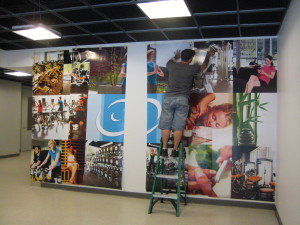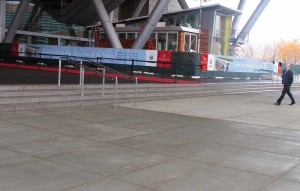Large format graphics
Large format graphics make a big splash
If you’re a buyer of trade show, conference and event printed materials and large graphics, or a buyer of museum exhibits or retail displays, here’s some valuable information you should know.
 Large format graphics have come a long way from the days of silkscreen printing. Today, thanks to the tremendous strides made in digital printing, there are countless more forms and uses for large format graphics.
Large format graphics have come a long way from the days of silkscreen printing. Today, thanks to the tremendous strides made in digital printing, there are countless more forms and uses for large format graphics.
There are posters, trade show graphics, wallpaper, murals, backlit film, vehicle image wraps, electronic circuit schematics, architectural drawings, construction plans, backdrops for theatrical
and media sets, and most any other type of large format artwork or signage.
Large format printers utilize some version of inkjet technology to produce the printed image. This is more cost-effective than other print methods such as silkscreen printing, especially when it comes to short-run print projects. Large format printers are categorized by the type of ink transfer process they employ. Most widely used include:
 Latex
Latex
Introduced by HP in 2008, latex inks are ideal for printing banners. They provide outstanding image quality. Also, during the printing process, latex inks melt onto the PVC substrate, sealing the pigments. Protecting pigments in this way allows banners to be hung outdoors. Not only that, but the protection helps them last up to three years in the elements without lamination. Latex inks can also be used on other types of substrates, specifically high density polyethylene (HDPE). This reinforced banner material is much lighter and stronger than PVC, and is completely recyclable. Better yet, it costs about the same as PVC, making it a great alternative. Latex inks are gaining in popularity at such a rapid clip that before too long they’re likely to replace aqueous and solvent inks when it comes to printing banners.
Aqueous
 Aqueous inks are either dye or UV (ultraviolet). Dye ink is a high-color, low UV-resistant variety that offers the widest color gamut. They’re used with thermal or inkjet printers. UV ink is generally duller in color, but is formulated to withstand fading from UV rays. Finished prints using dye inks must be laminated to protect them if they’re used outdoors, while prints using UV inks can be used outdoors without lamination, but not for an unlimited time. That said, aqueous inks, whether dye or UV, require all materials that they’re printed on, such as canvas, metabolized plastic and cloth, to be properly coated to accept and hold the ink.
Aqueous inks are either dye or UV (ultraviolet). Dye ink is a high-color, low UV-resistant variety that offers the widest color gamut. They’re used with thermal or inkjet printers. UV ink is generally duller in color, but is formulated to withstand fading from UV rays. Finished prints using dye inks must be laminated to protect them if they’re used outdoors, while prints using UV inks can be used outdoors without lamination, but not for an unlimited time. That said, aqueous inks, whether dye or UV, require all materials that they’re printed on, such as canvas, metabolized plastic and cloth, to be properly coated to accept and hold the ink.
Solvent
Solvent inks are any that are not water-based. For example, inks that use petroleum or a petroleum by-product, such as an acetone-like carrier liquid fall into this category. Eco-solvent inks also are part of this group. They generally contain glycol esters or glycol ether esters, and are slower drying, resulting in prints that are waterproof. Solvent inks can be used to print directly on uncoated vinyl and other media, as well as on ridged substrates, such as painted/coated metal, foamboard and PVC. Solvents soften the base material, which enables the ink pigments to mechanically latch onto the chemically etched surface, making solvent ink prints more durable than those with aqueous inks. It should be noted that they give off an odor when drying. However, it dissipates, allowing them to be used in an office environment with minimal or tolerable odor levels.
Dye sublimation inks are used to produce continuous-tone prints of photographic quality by being diffused into the print media.
UV
Piezo inkjet printers use inks are UV-curable, which means they dry when cured with UV light, resulting in prints that are waterproof, embossed and vibrant. Any media material can be used with these inks, but polymer-made media works best. Interestingly, ceramics, glass, metals, and woods can also work well when printed with UV-curable inks
Large format graphics, small environmental footprint
A while ago I wrote a blog about the role that large format printing plays in the issue of sustainability. You might find it interesting, especially in light of the subject of this blog.
 Let’s connect
Let’s connect
If you’d like to learn more about how we think here at Ferrante & Associates, subscribe to our blogs or our monthly Newsletter Ferrante Speaks. You may also follow us on Twitter, Google+ or Facebook.
Don’t miss out: Subscribe and receive regular updates delivered automatically via a web portal, newsreader or email.







